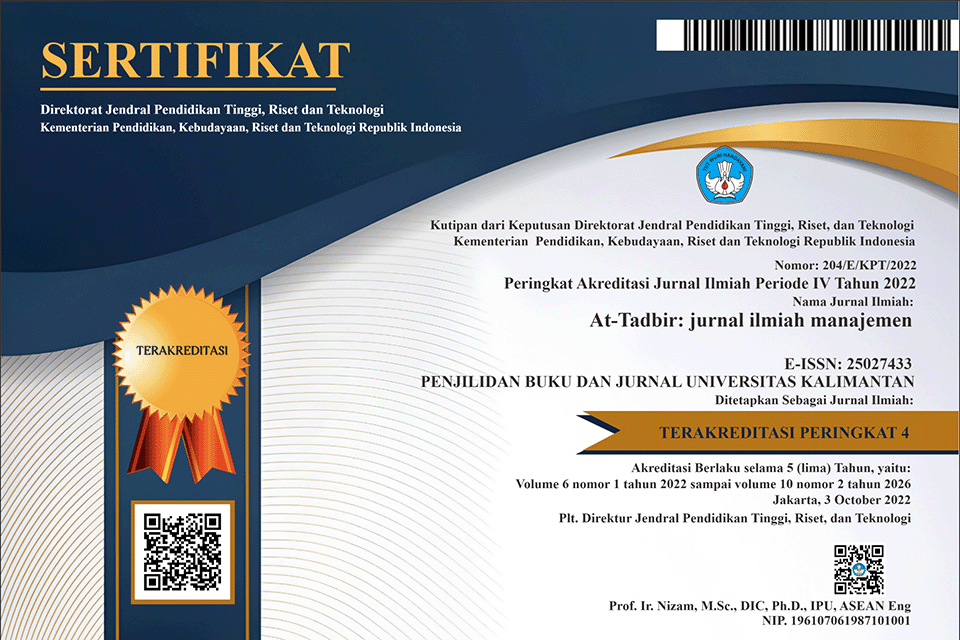PENGEMBANGAN RANCANGAN DAN PENGUKURAN KINERJA PERUSAHAAN DENGAN PENDEKATAN BALANCED SCORECARD (Studi Kasus di PT. Natra Raya)
(1) STIE Dahani Dahanai Buntok
(*) Corresponding Author
Abstract
PT. Natra Raya company is licensed by Catterpillar Inc. to produce the Caterpillar heavy equipment. The challenge in seizing market share requires companies to provide competitive prices. The increase in raw material prices, employee wages, transportation costs, charges the company more. The use of Balanced Scorecard on performance measurement helps companies create a comprehensive performance measurement system to measure company performance to be more efficient. This study uses two methods of analysis. The process of making a balanced scorecard design uses quantitative analysis while qualitative used to calculate process, measuring Key performance Indicators weight and performance range. The results of the survey with the balanced scorecard approach show that the performance of PT. Natra Raya is good with an index number of 103.4% (green code). The balanced scorecard method shows that the performance of PT. Natra Raya cannot only be measured in a limited way. This method can show that there are parts of the indicator that need special attention, namely KPIs with poor performance evaluation results shown in the sub-KPI of employee capability due to the KPI's focus on resources getting a bad score. The sub-KPI, when completing the project, gets a poor performance evaluation result, but outside of the three sub-KPIs, the results of PT. Natra Raya is good and very good.
Full Text:
73-89 (Bahasa Indonesia)References
Assauri, S. 1993. Manajemen Produksi. Edisi 4. Lembaga Penerbitan Fakultas Ekonomi Universitas Indonesia. Jakarta.
Basu, R. 2004. Six Sigma to Operational Excelence: role of tools and Techniques. International Journal Six Sigma and Competitive Advantage, Vol. 1. No.1, pp.44-64.
Gaspersz, V. 2001. balanced Scorecard: Alat Manajemen Kontemporer Untuk Melipat gandakan Kinerja Keuangan Perusahaan. Salemba Empat. Jakarta.
Gaspersz, V. 2001. The Strategy Focused Organization. How Balanced Scorecard Companies Thrive in The New Business Environment. Harvard Business School Press. Boston Massachussets.
Gasperz, V. 2003. Sistem Manajemen Kinerja Terintegrasi: Balanced Scorecard dengan Six Sigma untuk Organisasi dan Bisnis dan Pemerintah. PT. Gramedia Pustaka Utama. Jakarta.
Kaplan, R.S. dan D.P. Norton. 1992. The Balanced Scorecard Measures That Drive Performance. Harvard Business Review, January-February 1992. p. 71-19.
Kotter. J.P. 1997. Leading Change. Menjadi Pionir Perubahan. PT. Gramedia Pustaka Utama. Jakarta.
Ma'arif, M.S. dan Tanjung, H. 2003. Manajemen Operasi. Grasindo. Jakarta.
Pappas, J.L. and Hirschey, M. 1995. Ekonomi Manajerial. Binarupa Aksara. Jakarta.
Russel, R.S. and B.W. Taylor. 1998. Operation Management. Focusing on Quality and Competitiveness. 2nd edition. Prentice-Hall International Inc. New Jersey.
Stevenson, J.W. 1990. Production and Operation Management. Third Edition. Richard D. Irvin, Inc. Boston.
Tenner, A.R. dan de Torro, I.J. 1992. Total Quality Management: Three Steps to Continuous Improvements. Addison – Wesley Publishing Company.
Thomson, A., A.J. Strickland. 1996. Strategic Management. Richard Irwin Inc.
Umar, H. 2002. Strategic Management in Action. Gramedia Pustaka Utama. Jakarta.
Wheelen, T.L. and Hunger, J.D. 2001. Manajemen Strategis. Andi Yogyakarta.
Yuwono, S., E. Sukarno, M. Ichsan. 2002. Petunjuk Praktis Penyusunan Balanced Scorecard Menuju Organisasi yang Berfokus Pada Strategi. Gramedia Pustaka Utama. Jakarta
DOI: http://dx.doi.org/10.31602/atd.v3i2.1790
Refbacks
- There are currently no refbacks.
Copyright (c) 2019 sri wahyunawati
---------------------------------------------------------------------------------------------------------------------
At-Tadbir: Jurnal Ilmiah Manajemen is licensed under Creative Commons Attribution-Share A like 4.0 International License




